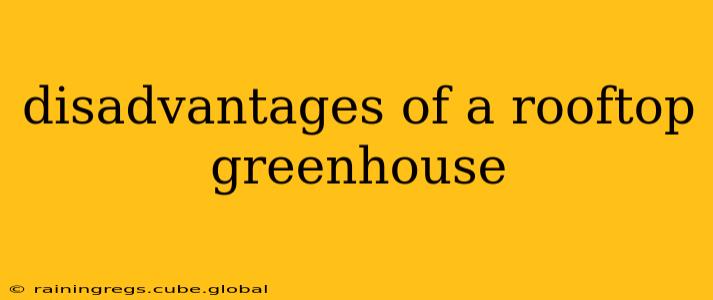Rooftop greenhouses offer an exciting solution for urban farming and sustainable food production. However, before you invest time and resources, it's crucial to understand the potential drawbacks. This comprehensive guide explores the disadvantages of rooftop greenhouses, helping you make an informed decision.
High Initial and Ongoing Costs:
One of the most significant disadvantages is the substantial upfront investment. Constructing a rooftop greenhouse requires specialized materials, skilled labor, and potentially structural modifications to the building itself. This includes not only the greenhouse structure but also the necessary infrastructure for water, electricity, and potentially climate control systems. Ongoing costs, such as maintenance, repairs, and energy consumption for heating and cooling, can also be substantial, especially in extreme climates.
Weight and Structural Load:
The weight of the greenhouse structure, soil, water, and plants can put considerable stress on the building's roof. Before even considering a rooftop greenhouse, you must conduct a thorough structural assessment to ensure the roof can handle the added weight. Failure to do so could result in significant damage to the building, leading to costly repairs or even collapse. This is a crucial factor often overlooked.
Access and Transportation:
Accessing a rooftop greenhouse can be challenging, requiring stairs, elevators, or other means of transport. This makes the transportation of materials, equipment, and harvested produce more difficult and potentially expensive than in ground-level operations. The logistical hurdles can significantly impact efficiency and profitability.
Exposure to the Elements:
Rooftop greenhouses are more exposed to extreme weather conditions than ground-level structures. This increased exposure makes them more vulnerable to damage from high winds, heavy snow, hail, and intense sunlight. This necessitates robust construction and potentially more costly protection measures.
What are the challenges of building a rooftop greenhouse?
This question encapsulates several of the above points. The challenges include securing appropriate building permits, dealing with structural limitations of the roof, managing access for construction and maintenance, and addressing the increased exposure to harsh weather conditions. The permitting process alone can prove lengthy and complex, potentially delaying or even preventing the project.
What are the disadvantages of growing plants on a roof?
While similar to the challenges of building a rooftop greenhouse, this question focuses on the plant's perspective. The disadvantages include limited soil depth, difficulty in irrigation and drainage, potential for extreme temperature fluctuations, and increased exposure to strong winds. These factors can negatively impact plant growth and yield.
What are some common problems with rooftop gardens?
This question broadens the scope beyond greenhouses to encompass the overall challenges of rooftop gardening. Common problems include weight limitations, wind damage, water access and drainage issues, lack of soil depth, extreme temperature variations, and pest and disease control. Many of these problems are exacerbated in a rooftop greenhouse setting.
What are the environmental considerations of rooftop greenhouses?
While rooftop greenhouses contribute to sustainable food production, there are environmental considerations. Energy consumption for heating and cooling can be high, potentially offsetting some of the environmental benefits. Water usage should be managed carefully to avoid water waste. The selection of building materials should prioritize sustainable and environmentally friendly options.
Conclusion:
While rooftop greenhouses offer potential benefits, it's crucial to carefully weigh the disadvantages. A thorough assessment of costs, structural integrity, access, weather exposure, and environmental impact is essential before embarking on this venture. By carefully considering these factors, you can determine whether a rooftop greenhouse is a viable and sustainable option for your needs.
